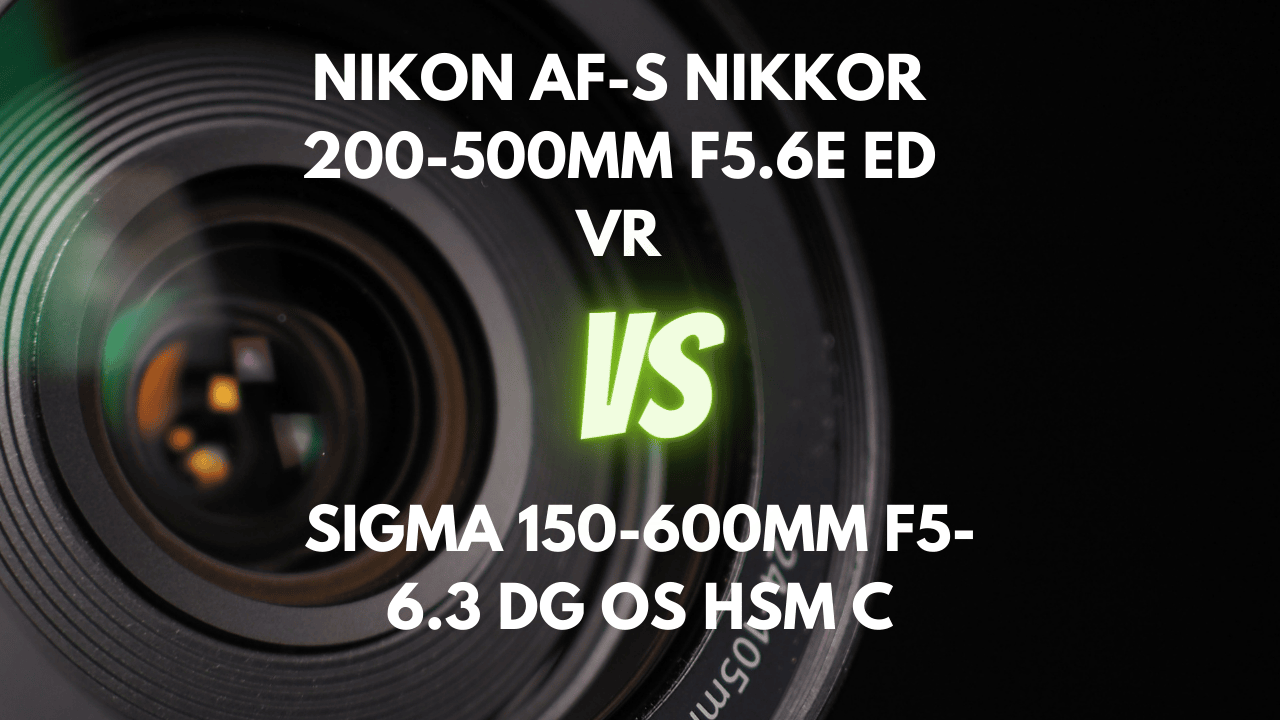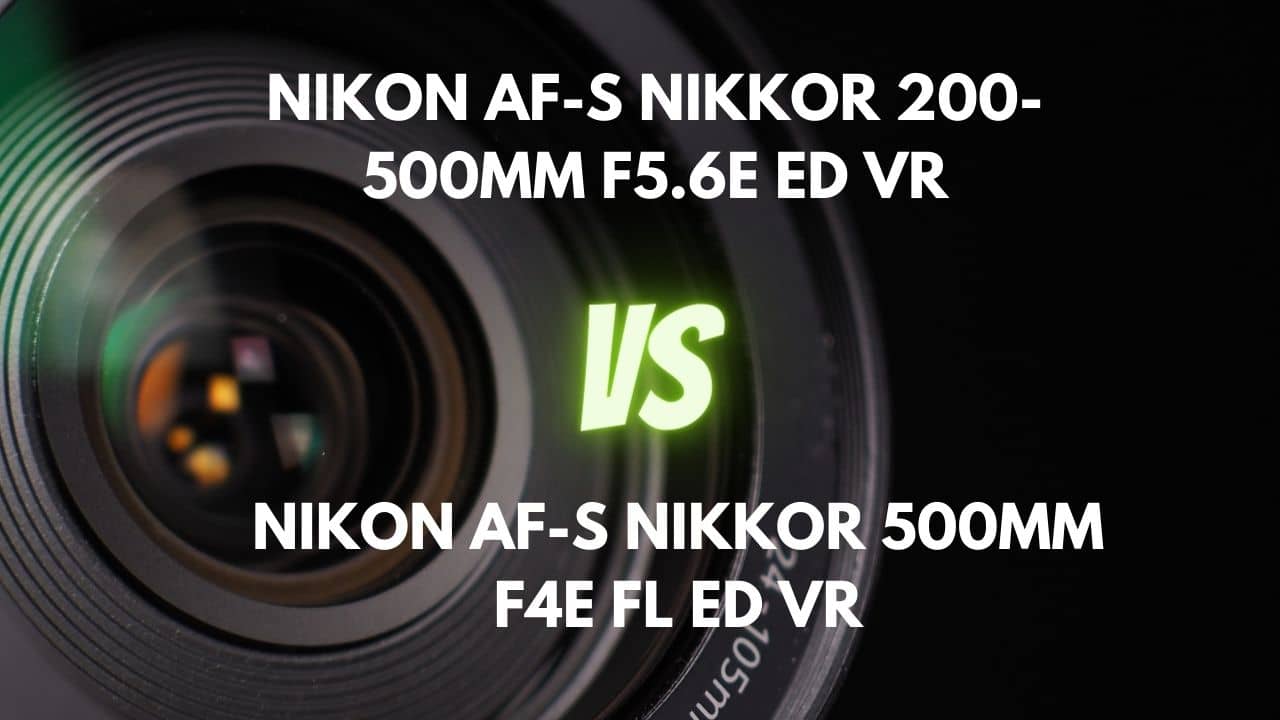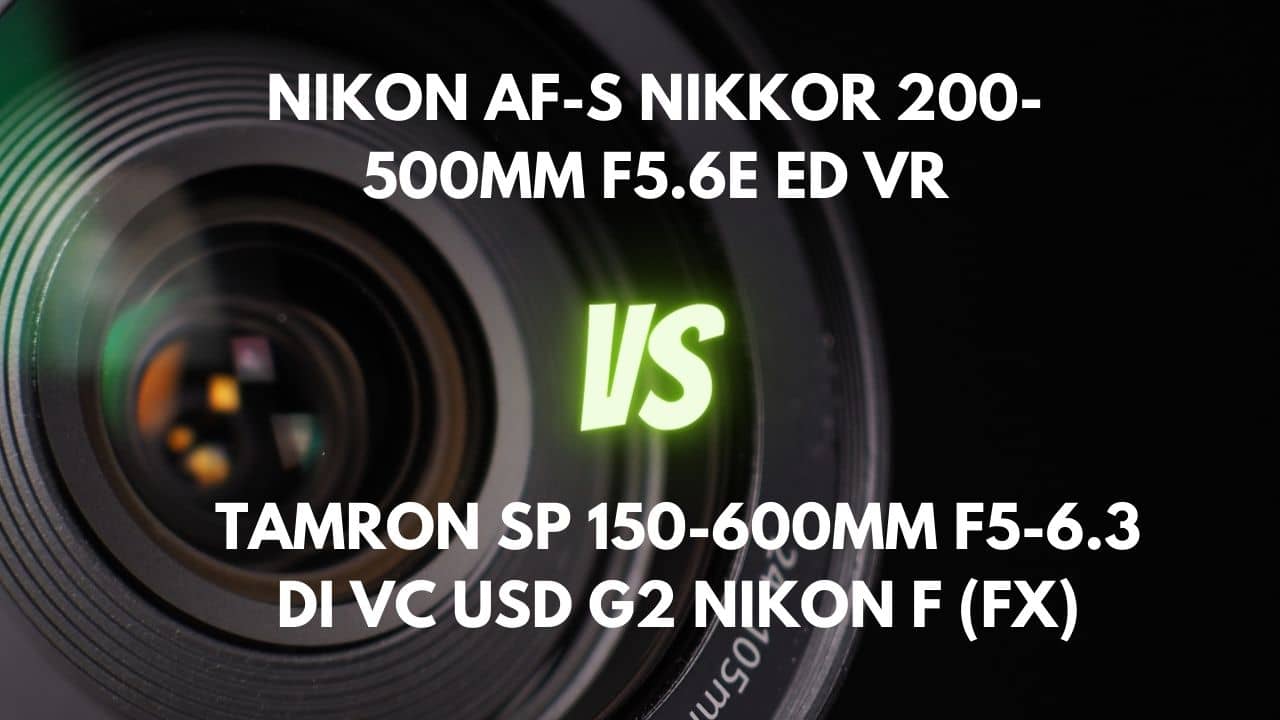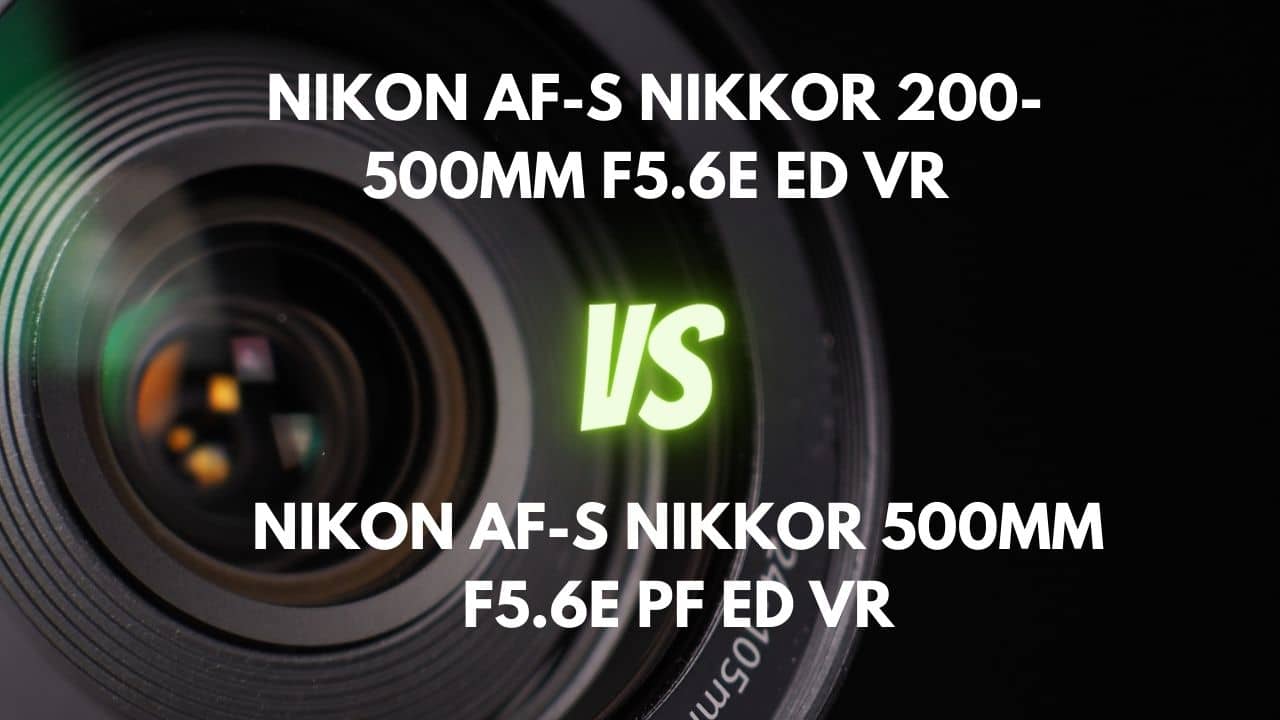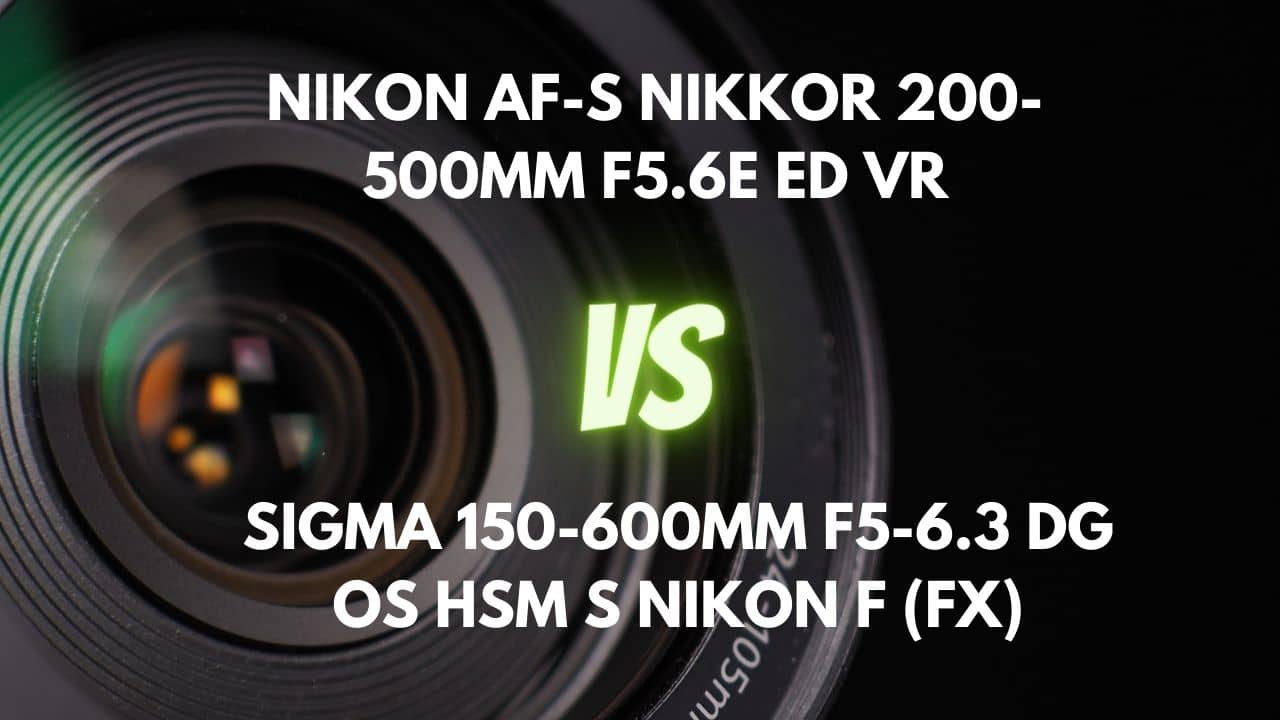Are you an avid sports or wildlife photographer on the hunt for the perfect telephoto lens to elevate your craft? You’re in luck!
Our in-depth comparison of the Nikon 200-500mm f/5.6 and Sigma 60-600mm f/4.5-6.3 Sports will provide you with the essential insights to make an informed decision tailored to your specific needs. As we know, sports and wildlife photography often require capturing fast-moving subjects in challenging conditions, and the right lens can be a game-changer.
In this comprehensive article, we’ll dive into the key features and performance aspects of both the Nikon and Sigma telephoto lenses, exploring focal range, portability, build quality, weather sealing, tripod collar functionality, autofocus performance, optical stabilization, aberration control, sharpness, flare/ghosting resistance, vignetting control, and distortion management. We’ll also discuss how each lens caters to different aspects of sports and wildlife photography, providing you with the knowledge to make the best choice for your unique preferences and requirements.
Get ready to up your photography game and capture those breathtaking moments with confidence and precision. Join us on this exciting journey as we uncover the strengths and weaknesses of these two popular telephoto lenses, and help you make the right choice for your photographic pursuits!
Overview
| Nikon AF-S NIKKOR 200-500mm F5.6E ED VR | Sigma 60-600mm F4.5-6.3 DG OS HSM S Nikon F (FX) | |
|---|---|---|
| Max Aperture | F5.6 | F4.5-6.3 |
| Aperture Type | Fixed | Variable |
| Focal Range (mm) | 200-500 | 60-600 |
| Mount Type | Nikon F (FX) | Nikon F (FX) |
| Zoom Ratio (X) | 2.5 | 10 |
Comparing the Nikon 200-500mm f/5.6 and Sigma 60-600mm f/4.5-6.3 Sports, we can see notable differences in their specifications.
The Nikon lens has a fixed aperture of f/5.6, while the Sigma lens has a variable aperture of f/4.5-6.3. A fixed aperture lens, like the Nikon, is typically better for low light situations and delivers more consistent image quality across the zoom range.
Regarding focal range, the Nikon lens offers a 200-500mm range, making it more specialized for telephoto photography. In contrast, the Sigma lens has a wider 60-600mm focal range, providing more versatility for various shooting scenarios.
Both lenses feature a Nikon F (FX) mount type, making them compatible with Nikon full-frame cameras.
For sports and wildlife photography, having a larger aperture and longer focal length can be beneficial. The Nikon lens, with its fixed aperture of f/5.6, will generally perform better in low light conditions, allowing for faster shutter speeds and better subject isolation due to a shallower depth of field. On the other hand, the Sigma lens offers more flexibility with its 60-600mm focal range, catering to a broader range of shooting situations.
In conclusion, if you prioritize low light performance and consistent image quality, the Nikon 200-500mm F5.6 fixed aperture lens is the superior choice. However, if you value versatility and a wider focal range for various shooting scenarios, the Sigma 60-600mm f/4.5-6.3 variable aperture lens may be the better option for you.
Design and Ease of Use
| Nikon AF-S NIKKOR 200-500mm F5.6E ED VR | Sigma 60-600mm F4.5-6.3 DG OS HSM S Nikon F (FX) | |
|---|---|---|
| Diameter x Length (mm) | ⌀108×267.5mm | ⌀120×269mm |
| Weight (gr) | 2300 | 2700 |
| Filter Thread (mm) | 95 | 105 |
| Weather Sealing | No | Yes |
| Zoom Method | Rotary (extending) | Rotary (extending) |
| Distance Scale | Yes | Yes |
| DoF Scale | No | No |
| Hood Supplied | Yes | Yes |
| Tripod Collar | Yes | Yes |
Comparing the Nikon 200-500mm f/5.6 and Sigma 60-600mm f/4.5-6.3 Sports in terms of size and weight, the Nikon lens has a diameter of 108mm and a length of 267.5mm, while the Sigma lens is slightly larger, with a diameter of 120mm and a length of 269mm. In terms of weight, the Nikon lens is lighter at 2300g, whereas the Sigma lens weighs 2700g.
For sports and wildlife photography, dimensions and weight play a significant role in the overall shooting experience. A more compact and lightweight lens, like the Nikon, is easier to carry around and can be less tiring during long shooting sessions. The lighter weight also contributes to better balance on your camera setup, making it more comfortable to handle. Additionally, a smaller and lighter lens can provide a level of discreetness that may be useful for capturing candid shots without drawing too much attention.
On the other hand, the larger and heavier Sigma lens might offer more versatility in terms of zoom range; however, the increased size and weight can lead to a more cumbersome experience, especially during extended shoots. Swapping lenses might also be more challenging due to the larger size and weight of the Sigma lens.
In conclusion, based on dimensions and weight alone, the Nikon lens is the superior choice for sports and wildlife photography, as it offers better portability, balance, and discreetness. The lighter Nikon lens will provide a more comfortable shooting experience, allowing you to focus on capturing the perfect shot without being weighed down by cumbersome gear.
Lens Mount and Barrel
When comparing the Nikon 200-500mm f/5.6 and Sigma 60-600mm f/4.5-6.3 Sports based on their lens mount and barrel design, it’s essential to take into consideration the materials used and their impact on performance and durability.
The Nikon lens mount is constructed from metal and features a rubber gasket to safeguard against dust and moisture, ensuring a secure and well-protected connection. Similarly, the Sigma lens mount is also made of metal and has a rubber gasket for protection against dust and dirt infiltration.
Focusing on the lens barrel, the Nikon lens combines metal and high-grade plastic materials, resulting in a lighter and more portable design. Its telescoping mechanism allows for smooth zooming, and the lock feature keeps the lens at the shortest 200mm length to prevent unintentional extension.
In contrast, the Sigma lens barrel is made of a blend of magnesium, carbon fiber, and thermally stable composite materials, offering durability and lightweight construction. The lens barrel length adjusts by around 95mm when zooming, and each of the ten focal length intervals can be locked into position.
While plastic lens barrels are lighter and more affordable, metal lens barrels tend to be sturdier and more durable. The Nikon lens strikes a balance between weight and durability, while the Sigma lens leans towards a more robust construction with its choice of materials.
In conclusion, if you prioritize portability and affordability, the Nikon lens offers a suitable combination of materials for its lens mount and barrel. However, if durability and a professional feel are more important to you, the Sigma lens with its magnesium, carbon fiber, and composite construction may be the superior choice.
Weather Sealing
When comparing the Nikon 200-500mm f/5.6 and Sigma 60-600mm f/4.5-6.3 Sports based on their weather sealing, it’s essential to consider the protection they offer against environmental elements such as dust, moisture, and light water splashes.
The Nikon lens is not fully weather-sealed but provides some protection against the elements. It features a rubber gasket at the lens mount to help prevent water ingress. The absence of internal seals on the rings, switches, and barrel front, coupled with the front element’s lack of fluorine coating, is noticeable. Although the lens can handle some cold, dust, and moisture, it is not designed for heavy use or extreme weather conditions typically encountered in sports and wildlife photography.
On the other hand, the Sigma lens boasts a Dust and Splash Resistant Structure, applied to various parts of the lens to prevent dust and dirt from entering. It also features a rubber grommet at the mount and a Water and Oil Repellent Coating on the front element, making it easier to clean and more resistant to water drops and smudges.
In the context of sports and wildlife photography, where lenses are often exposed to harsh weather conditions and challenging environments, the Sigma lens offers superior weather sealing. Its comprehensive protection against dust, moisture, and water splashes ensures durability and performance, allowing photographers to focus on capturing stunning images without worrying about potential damage to their equipment.
Rings
With its ribbed zoom ring and textured rubber focus ring, the Nikon 200-500mm f/5.6 boasts two rings that offer not only a quality feel but also smooth rotation. The zoom ring is placed towards the front, and it takes almost 180 degrees of rotation to zoom from 200mm to 500mm.
The focus ring is closer to the camera body, allowing for easy change of focal length while maintaining balance and grip. The lens has a zoom lock switch at 200mm and a focus limiter function with full-time manual focus override in M/A position. There is a windowed distance scale for convenience.
The Sigma 60-600mm f/4.5-6.3 Sports has two large control rings for manual focus and zoom. The focus ring is positioned closer to the camera body, broad, rubberized, and offers smooth and precise rotation. The zoom ring is wider and requires more effort to turn due to the weight of the optical block. It has a tactile method for locating the ring and transitions between focal lengths with 123 degrees of rotation.
There is no zoom creep, and an extension lock switch prevents lens creep or locks the lens at a specific focal length. The lens has a manual override mode, and the focus scale is always visible.
In conclusion, both lenses offer well-designed rings that ensure comfortable handling and precise control. However, the Sigma lens have a slight edge in terms of the build quality and smoothness of the focus ring. The focus and zoom ring placements on both lenses are convenient and easy to use, but the Sigma lens provides a more tactile experience, making it easier to locate and adjust the rings.
Switches/Buttons
The Nikon 200-500mm f/5.6 features four switches on the side, including an AF/MF switch for full-time manual focus override, a focus limiter switch to restrict autofocus distance, an IS switch for vibration reduction, and a VR mode switch for normal and sport modes. The switches are easy to locate and use, and the focus and zoom rings are well-designed and textured for comfortable handling.
The Sigma 60-600mm f/4.5-6.3 Sports offers a variety of switches for functionality and ease of use. It has an AF/MF switch for toggling between autofocus and manual focus, a focus limiter with three options, an optical stabilization mode switch, and a custom mode switch for various settings. The buttons are placed within a 90-degree arc for convenient access and have solid clicks and firm operation. Some switches feature white backgrounds to indicate set positions visually. While the top AF/MF switch is well-sized, the other three switches may feel slightly cramped and stiff.
In conclusion, both lenses have well-designed switches and buttons that cater to different functionalities. The Nikon lens offers a straightforward, easy-to-use switch layout, while the Sigma lens provides more customization options with its additional focus limiter settings and custom mode switch.
However, the Sigma lens’s switches might feel a bit cramped for some users. Overall, the Nikon lens has a slight edge in terms of user-friendliness and ease of use, while the Sigma lens is more versatile with its additional settings and customization options.
Filter Thread
The Nikon 200-500mm f/5.6 features a filter thread of 95mm, which is not a very common size. Despite the uncommon size, it benefits from a metal filter thread for durability and a secure fit for filters. Additionally, the front element and filter thread do not rotate during focusing, making it suitable for using polarizers and graduated neutral density filters. High-quality filters from reputable brands like B+W and Hoya are available for compatibility with this lens.
On the other hand, the Sigma 60-600mm f/4.5-6.3 Sports has a larger filter thread size of 105mm, which may result in more expensive filters. Similar to the Nikon lens, the front element and filter thread do not rotate during focusing, allowing for the use of polarizing or graduated filters. However, the large filter size may pose challenges in finding filters, and they could be more costly compared to more common sizes.
In conclusion, the Nikon lens has a slight advantage in filter thread size, as the 95mm size, though uncommon, is easier to find and less expensive than the Sigma lens’s 105mm size. The non-rotating front elements of both lenses ensure compatibility with polarizing and graduated filters. If you prioritize filter compatibility and affordability, the Nikon lens may be a better choice. However, if you are willing to invest in larger, potentially more expensive filters, the Sigma lens could still be a suitable option for your photography needs.
Lens Hood
The Nikon 200-500mm f/5.6 comes with a lens hood that is included in the package. It features a one-piece plastic bayonet design, which can be reversed and placed back on the lens when transporting. The lens hood is large, with a 5″ diameter and 4″ length, and effectively blocks unwanted light. Made of plastic with a smooth finish, the lens hood can be rotated smoothly.
In contrast, the Sigma 60-600mm f/4.5-6.3 Sports also includes a lens hood in the package, but it is made from a combination of carbon fiber and plastic, making it lightweight and durable. The interior of the hood is mold-ribbed, which helps to prevent light reflections, while the exterior has a rubberized rim for a secure grasp when installing or removing.
This rubberized rim also prevents the lens from sliding on surfaces and protects both the lens and the surface. The hood attaches via a large thumbscrew for a secure connection, and the built-in collar allows for smooth rotation through 360 degrees with notches at 90-degree intervals for quick orientation changes.
In conclusion, the Sigma lens hood has an edge over the Nikon lens hood due to its combination of carbon fiber and plastic construction, mold-ribbed interior for light reflection prevention, and rubberized rim for better grip and protection. The Sigma lens hood also offers a more secure attachment with its thumbscrew and allows for easier rotation and orientation changes.
Tripod Collar
To provide a stable platform while using a tripod, the Nikon 200-500mm f/5.6 comes equipped with a tripod collar. However, the collar’s single point of connection, located at the far back of the lens barrel, could be improved with a two-point stabilization system, similar to those found in replacement lens collars from Kirk and RRS.
Although not directly compatible with Arca-Swiss, many photographers opt to replace the tripod collar on the Nikon lens with an aftermarket one, as it provides better support and compatibility. Additionally, the collar can be easily removed when not needed, which enhances the lens’s comfort during handheld use.
On the other hand, the Sigma 60-600mm f/4.5-6.3 Sports features a well-designed tripod collar that is both sturdy and easy to use. Secured with a thumb screw, the collar on the Nikon lens supports 360-degree rotation with 90-degree click stops. Importantly, the tripod foot is Arca-Swiss compatible, enabling direct mounting onto Arca-Swiss tripod heads without requiring a separate quick release plate.
There are strap connection points on either side of the tripod collar for added convenience. While the tripod collar is not removable, the tripod foot can be removed and replaced if needed.
In conclusion, the Sigma lens offers a superior tripod collar compared to the Nikon lens. Its Arca-Swiss compatibility, 360-degree rotation with 90-degree click stops, and strap connection points make it more convenient and user-friendly for sports and wildlife photographers. Although the Nikon lens’s tripod collar can be removed for handheld use, the Sigma lens provides better overall functionality and compatibility for tripod use, making it the preferable choice for tripod-supported photography.
Focusing and Optical Stabilization
| Nikon AF-S NIKKOR 200-500mm F5.6E ED VR | Sigma 60-600mm F4.5-6.3 DG OS HSM S Nikon F (FX) | |
|---|---|---|
| Autofocus | Yes | Yes |
| AF Motor | Silent Wave Motor | Hyper Sonic Motor |
| Rotating Front Element | Does not rotate on focusing | Does not rotate on focusing |
| Min Focus Distance | 2.2m | 0.6m |
| Max Magnification (X) | 0.22 | 0.3 |
| Full-Time Manual Focus | Yes | Yes |
| Focus Method | Internal | Internal |
Focusing Performance
As the Nikon 200-500mm f/5.6 is equipped with a built-in Silent Wave Motor (SWM), it can provide quiet autofocus operation, and when set to the M/A position, it also allows for full-time manual focus override. Its autofocus speed is noteworthy, with initial focus acquisition being faster than that of many f/1.8 Nikon primes. The Nikon lens boasts impressive autofocus speed, taking around 1 second to focus from close to infinity at 500mm and approximately 0.7 seconds at 300mm.
While its low-light performance is generally decent, it may slow down slightly at 500mm. The lens’s focusing accuracy and consistency are excellent, and the manual focus action is smooth, thanks to the wide focus ring that enables precise focus adjustment. The lens also boasts an internally focusing design, making it convenient to use with polarizing filters.
In contrast, the Sigma 60-600mm f/4.5-6.3 Sports offers solid autofocus performance, with its High-response Linear Actuator (HLA) motor providing quick, precise, and quiet focusing. The focusing speed is generally fast, taking about 0.15 seconds to lock onto a subject, and it can drive focus from close to distant subjects in an instant. In low-light situations, the lens still performs well with minimal hunting. Its initial autofocus acquisition speed is good, and it can focus accurately throughout the focal length range.
The Sigma lens also features manual focus override and smooth manual focus action, thanks to the broad and rubberized focus ring. Like the Nikon lens, the Sigma lens has an internally focusing design, maintaining a constant length regardless of focus and zoom settings. Additionally, it exhibits minimal focus breathing, ensuring consistent composition throughout the focusing range.
Considering the importance of autofocus performance in sports and wildlife photography, the Sigma lens appears to be superior in terms of focusing performance. Its High-response Linear Actuator (HLA) motor, quick autofocus speed, and minimal hunting in low-light situations make it better suited for capturing fast-moving subjects and maintaining sharpness across the focal length range. While the Nikon lens also has commendable focusing performance, the Sigma lens’s faster autofocus speed and better low-light performance make it the more appealing option for sports and wildlife photographers.
Optical Stabilization
Equipped with an effective Vibration Reduction (VR) system, the Nikon 200-500mm f/5.6 can provide up to 4.5 stops of stabilization. This allows for sharp images even at slower shutter speeds, making it suitable for both photography and video recording.
Two stabilization modes, Normal and Sport, are available on the lens, with Sport mode optimized for tracking fast-moving subjects. When the VR is enabled, the Nikon lens can capture usable shots at shutter speeds as slow as 1/60 seconds while shooting at 500mm, and in some cases, it can even go down to 1/25 seconds, which demonstrates the remarkable performance of its stabilization system.
In contrast, the Sigma 60-600mm f/4.5-6.3 Sports features an impressive optical stabilization system that can offer up to 4 stops of assistance. Although it produces a faint hum during operation, with audible clunks at startup and shutdown, it remains effective across the entire zoom range.
The lens features two main stabilization modes: Mode 1 for standard use and Mode 2 for panning. Custom settings (C1 and C2) are also available for further fine-tuning the optical stabilization. In practice, the system enables sharp handheld photos even at shutter speeds as low as 1/8-second at 600mm.
Considering the importance of optical stabilization in sports and wildlife photography, especially when using telephoto lenses, the Nikon lens appears to be superior in this aspect. With its 4.5 stops of stabilization and a quieter operation, it provides better performance in challenging conditions, such as low light or fast-moving subjects. While the Sigma lens also offers effective stabilization, the Nikon lens’s higher level of stabilization and silent operation make it a more suitable choice for sports and wildlife photographers seeking the best possible optical stabilization.
Image Quality
| Nikon AF-S NIKKOR 200-500mm F5.6E ED VR | Sigma 60-600mm F4.5-6.3 DG OS HSM S Nikon F (FX) | |
|---|---|---|
| Special Elements | 3 ED elements | 1 SLD + 3 FLD elements |
| Diaphragm Blades | 9 | 9 |
| Circular Aperture | Yes | Yes |
Aberration
The Nikon 200-500mm f/5.6 exhibits minimal chromatic aberration, making it difficult to find color fringing even on extremely contrasted edges. Although chromatic aberration levels are low at 200mm and 300mm, they increase slightly at 400mm and 500mm focal lengths.
The lens displays some cat’s-eye effect towards the sensor’s borders/corners and noticeable coma. Additionally, the bokeh exhibits an “onion-ring” effect. However, spherical aberration is significantly reduced by the extra-low dispersion lens elements, contributing to the lens’s overall sharpness and contrast.
In contrast, the Sigma 60-600mm f/4.5-6.3 Sports demonstrates a range of aberrations, including chromatic aberration, coma, and spherical aberration. Chromatic aberration is mostly well-controlled, though purple fringing is occasionally visible around bright white areas, particularly towards the image corners.
Longitudinal chromatic aberrations are minimal and only slightly noticeable in certain high-contrast transition areas. Spherical aberration and spherochromatism contribute to a less sharp, hazy-appearing image quality at the widest apertures. Stopping down one to two stops effectively removes this aberration.
Based on the comparison, the Nikon lens performs better in terms of aberration control, exhibiting minimal chromatic aberration and benefiting from the use of extra-low dispersion lens elements to reduce spherical aberration. This results in better overall sharpness and contrast. While the Sigma lens also controls chromatic aberration reasonably well, it struggles more with spherical aberration and spherochromatism at wider apertures.
Sharpness
The Nikon 200-500mm f/5.6 exhibits excellent center sharpness throughout the zoom range, though it does display some corner softness at longer focal lengths and wide open apertures. Stopping down to around f/11 improves corner sharpness significantly. When set to f/5.6, the lens displays exceptional center sharpness at 200mm, which reaches a superb level at f/8. Nonetheless, sharpness tends to decrease as you zoom in, with a visible drop at 500mm, but it still remains serviceable. If you employ a teleconverter, it may affect autofocus precision and cause further sharpness reduction.
On the other hand, the Sigma 60-600mm f/4.5-6.3 Sports offers impressive center sharpness throughout the focal length range, with only minor concerns at the telephoto end. Corner sharpness is not as consistent, showing some softness at certain focal lengths, but improves when stopping down the aperture. At wide open aperture, the center sharpness is generally good, especially at shorter focal lengths. Stopping down can enhance sharpness, with the optimal aperture varying across the focal length range.
In conclusion, both lenses offer commendable sharpness performance. The Nikon lens delivers excellent center sharpness throughout the zoom range, although it experiences some decline at longer focal lengths. The Sigma lens also provides impressive center sharpness, but its corner sharpness is not as consistent. Overall, the Nikon lens has a slight edge in sharpness, particularly at shorter focal lengths, making it the superior choice in terms of sharpness.
Bokeh Quality
The Nikon 200-500mm f/5.6 generates a pleasing bokeh quality, characterized by smooth and beautiful out-of-focus areas. This is facilitated by the lens’s iris diaphragm, which contains 9 rounded aperture blades contributing to the attractive rendition of out-of-focus areas.
Specular highlights and background isolation are handled effectively, resulting in appealing bokeh without onion-shaped highlights or distracting patterns. Moreover, the bokeh balls produced by the Nikon lens exhibit minimal longitudinal chromatic aberration. Although the cat’s-eye effect is noticeable, it isn’t excessively obtrusive.
On the other hand, the Sigma 60-600mm f/4.5-6.3 Sports also produces an appealing bokeh quality, often described as smooth and creamy in various situations. This is primarily due to its 9 rounded blades in the iris diaphragm, contributing to the smooth out-of-focus areas.
The bokeh appears particularly nice at longer focal lengths, and when there is a significant distance between the subject and its background, a nicely blurred background can be achieved. However, it is crucial to acknowledge that bokeh evaluation is subjective and can vary based on individual preferences and shooting conditions.
In conclusion, both lenses deliver a pleasing bokeh quality, with each offering smooth out-of-focus areas. The Nikon lens has a slight advantage in handling specular highlights and background isolation, which leads to more appealing bokeh. Thus, the Nikon lens is slightly superior in terms of bokeh quality, although it is important to remember that personal preferences and shooting conditions can influence bokeh perception.
Flare/Ghosting
The Nikon 200-500mm f/5.6 displays good flare resistance, but ghosting and flare can still be problematic if a strong light source is directly in the frame or near the edge of the image. However, as long as the light is clearly outside the image-frame, there are no artifacts produced. The flare patterns generated by this lens are simple and devoid of additional coloration. It is essential to be cautious about strong light sources directly outside the frame, but aside from that, the flare and ghosting performance is good.
On the other hand, the Sigma 60-600mm f/4.5-6.3 Sports exhibits good flare resistance, particularly considering its complex optical design with 25 elements in 19 groups. Due to the narrow angle of view at longer focal lengths, it’s less likely to have the sun in the frame. When tested intentionally with the sun in the frame, minimal impact from flare and ghosting was observed even when the aperture was wide open or stopped down to f/11. The lens coatings and design help minimize flare effects, but under certain conditions with bright light sources in the frame, some flare artifacts may still be present.
In conclusion, both lenses exhibit good flare resistance. The Nikon lens has some limitations when strong light sources are near the edge of the image, while the Sigma lens performs well even with the sun in the frame. Given the Sigma lens’s more reliable performance under a wider range of conditions, it is superior in terms of flare and ghosting resistance.
Vignetting
Nikon 200-500mm f/5.6 offers exceptional vignetting control, exhibiting only slight edge darkening beyond 300mm when focused at infinity. Vignetting is practically absent at shorter focal lengths. While some vignetting may be present, it can be effortlessly rectified in post-processing and can even enhance the images with its delightful quality.
In contrast, the Sigma 60-600mm f/4.5-6.3 Sports exhibits noticeable vignetting, particularly at the widest aperture settings and focal lengths. At 60mm f/4.5, there is about 2.5-stops of vignetting in the corners. By 100mm, f/5, the vignetting decreases significantly to around 1.2-stops.
As you progress through the focal length range towards 600mm, the vignetting increases again, reaching nearly 2-stops at f/6.3. By narrowing the aperture, vignetting gradually resolves, with only about 0.2-stops remaining at f/16.
For APS-C format cameras, vignetting is mostly avoided, with only slight shading present under certain scenarios. In general, vignetting can be corrected during post-processing or used creatively to draw attention to the center of the frame.
In conclusion, the Nikon lens demonstrates superior vignetting control compared to the Sigma lens, particularly at longer focal lengths. While the Sigma lens does exhibit more vignetting, it can still be corrected in post-processing or employed artistically.
Distortion
The Nikon 200-500mm f/5.6 displays minor pincushion distortion across various settings and distances, but it is typically not noticeable in real-world scenarios. Nearly all Nikon DSLRs possess automatic distortion correction capabilities, and for those that don’t, removing the distortion is a breeze with the Lens Distortion tool in Photoshop. Even though there may be some flaws, the lens still manages to capture sharp images with hardly any linear distortion. In general, distortion is manageable and easily corrected in post-processing.
On the other hand, the Sigma 60-600mm f/4.5-6.3 Sports exhibits different types of distortion throughout its focal length range. At the wide end, you can expect moderate barrel distortion, which gradually transitions into pincushion distortion as you move towards the longer focal lengths. The pincushion distortion is noticeable but not severe, and it might affect images with straight lines near the frame’s borders. Although distortion can be corrected in post-processing, it’s always better to minimize it in-camera by choosing the right focal length and lens combination.
In conclusion, the Nikon lens demonstrates a slight advantage in terms of distortion control, with minor pincushion distortion that can be easily corrected in post-processing. The Sigma lens, while exhibiting both barrel and pincushion distortion, requires more attention to focal length choice and may necessitate post-processing adjustments for optimal results.
Final Verdict
After evaluating the two telephoto lenses across various aspects, the final verdict is as follows:
The Nikon 200-500mm f/5.6 excels in portability, weight, sharpness, optical stabilization, vignetting control, and distortion management. Its compact and lightweight design is ideal for sports and wildlife photography, allowing for a comfortable shooting experience. Furthermore, it offers impressive sharpness, particularly at shorter focal lengths, and superior optical stabilization, which is crucial in challenging conditions.
The Sigma 60-600mm f/4.5-6.3 Sports, on the other hand, stands out in terms of focal range versatility, build quality, weather sealing, tripod collar functionality, autofocus performance, and flare/ghosting resistance. Its wide focal range makes it more adaptable to various shooting scenarios, and its comprehensive weather sealing ensures durability in harsh conditions. Additionally, its superior autofocus performance is particularly beneficial for capturing fast-moving subjects.
In conclusion, if portability, weight, sharpness, and optical stabilization are more important, the Nikon lens is the superior choice. However, if versatility, build quality, weather sealing, and autofocus performance are the priorities, the Sigma lens is the better option.


